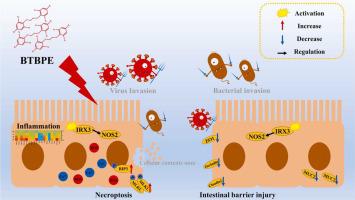Journal of Hazardous Materials ( IF 12.2 ) Pub Date : 2023-09-21 , DOI: 10.1016/j.jhazmat.2023.132597 Yuan Cui 1 , Qianqian Xiao 1 , Zhenyu Wang 1 , Qiong Zhang 1 , Yuetong Liu 1 , Weidong Hao 1 , Jianjun Jiang 1 , Qinghe Meng 1 , Xuetao Wei 1

|
Novel brominated flame retardants are widely used in electronics, textiles, furniture, and other products; they can enter the human body through ingestion and respiration and cause harm to the human body, and have been proven to have potential biological toxicity and accumulation effects. 1,2-bis(2,4,6-tribromophenoxy) ethane (BTBPE) is a widely used novel brominated flame retardant; however, there is a lack of research on its mechanism of toxicity, particularly that of intestinal toxicity. Currently, studies on the functionality of iroquois homeobox 3 (IRX3) are extremely limited. In our study, BTBPE was administered to Sprague-Dawley (SD) rats and rat small intestinal crypt epithelial cells (IEC6 cells) in vivo and in vitro, respectively, and hematoxylin and eosin (HE), immunohistochemical, Alcian blue-periodic acid-Schiff (AB-PAS), CCK8, acridine orange/ethidium bromide (AO/EB), fluorescent probes, qPCR, western blotting, and immunofluorescence analyses were performed. To explore the damage mechanism of BTBPE, we used siRNA to silence IRX3 and iNOs-IN-1 (yeast extract-peptone-wheat; YPW) to inhibit nitric oxide synthase 2 (NOS2). The results showed that BTBPE exposure caused inflammation and necroptosis in the jejunum and ileum, as well as destruction of the tight junctions and mucus layer. Moreover, BTBPE activated the IRX3/NOS2 axis both in vivo and in vitro. Silencing IRX3 or inhibiting NOS2 inhibits necroptosis and restores tight junctions in IEC6 cells. In conclusion, our study found that in the jejunum, ileum, and IEC6 cells, BTBPE exposure caused necroptosis and tight junction destruction by activating the IRX3/NOS2 axis. Blocking the IRX3/NOS2 axis can effectively inhibit necroptosis and restore tight junction. In addition, BTBPE exposure caused inflammation and loss of the mucous layer in the jejunum and ileum. Our study is the first to explore the mechanism of intestinal damage caused by BTBPE exposure and to discover new biological functions regulated by the IRX3/NOS2 axis, providing new research directions for necroptosis and tight junctions.
Environmental Implication
BTBPE is widely present in natural environments, including water, air, and soil, as well as in daily life-associated activities. Widespread exposure and long-term accumulation of BTBPE make it impossible to ignore its toxic effects. The digestive tract is a common route of BTBPE exposure. However, there is currently a lack of research on the mechanisms underlying the intestinal toxicity of BTBPE. Our study is the first to explore the mechanism of intestinal damage caused by BTBPE exposure and discover new biological functions regulated by the IRX3/NOS2 axis.
中文翻译:

1,2-双(2,4,6-三溴苯氧基)乙烷是一种新型溴化阻燃剂,通过 IRX3/NOS2 轴破坏大鼠小肠的肠道屏障功能
新型溴化阻燃剂广泛应用于电子、纺织、家具等产品;它们可通过食入和呼吸进入人体对人体造成危害,并已被证明具有潜在的生物毒性和蓄积作用。1,2-双(2,4,6-三溴苯氧基)乙烷(BTBPE)是一种广泛使用的新型溴化阻燃剂;但对其毒性机制,尤其是肠道毒性的机制尚缺乏研究。目前,关于 iroquois homeobox 3 (IRX3) 功能的研究极其有限。在我们的研究中,分别在体内和体外对 Sprague-Dawley (SD) 大鼠和大鼠小肠隐窝上皮细胞 (IEC6 细胞) 施用 BTBPE,并使用苏木精和伊红 (HE)、免疫组织化学、阿新蓝-高碘酸-进行了 Schiff (AB-PAS)、CCK8、吖啶橙/溴化乙锭 (AO/EB)、荧光探针、qPCR、蛋白质印迹和免疫荧光分析。为了探索BTBPE的损伤机制,我们使用siRNA沉默IRX3和iNOs-IN-1(酵母提取物-蛋白胨-小麦;YPW)来抑制一氧化氮合酶2(NOS2)。结果表明,BTBPE 暴露引起空肠和回肠炎症和坏死性凋亡,以及紧密连接和粘液层的破坏。此外,BTBPE 在体内和体外均激活 IRX3/NOS2 轴。沉默 IRX3 或抑制 NOS2 可抑制坏死性凋亡并恢复 IEC6 细胞中的紧密连接。总之,我们的研究发现,在空肠、回肠和 IEC6 细胞中,BTBPE 暴露通过激活 IRX3/NOS2 轴导致坏死性凋亡和紧密连接破坏。阻断IRX3/NOS2轴可以有效抑制坏死性凋亡并恢复紧密连接。此外,BTBPE 暴露会导致空肠和回肠炎症和粘膜层损失。我们的研究首次探讨了BTBPE暴露引起肠道损伤的机制,并发现了IRX3/NOS2轴调控的新生物学功能,为坏死性凋亡和紧密连接提供了新的研究方向。
环境影响
BTBPE广泛存在于水、空气、土壤等自然环境以及日常生活相关活动中。BTBPE的广泛接触和长期积累使其毒性作用不容忽视。消化道是 BTBPE 暴露的常见途径。然而,目前缺乏BTBPE肠道毒性机制的研究。我们的研究首次探讨了 BTBPE 暴露引起肠道损伤的机制,并发现了 IRX3/NOS2 轴调控的新生物学功能。






























 京公网安备 11010802027423号
京公网安备 11010802027423号